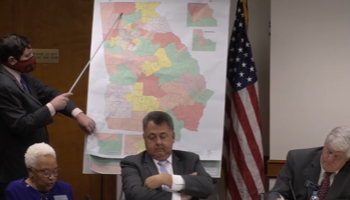New Alabama, Georgia congressional maps could yield victories for Black voters in 2024
Published 9:34 am Friday, October 27, 2023
Ahead of a big election year, new court-ordered congressional maps in Alabama and Georgia could yield new victories for Black voters in 2024.
Judges against both states’ Republican-drawn maps ordered that new maps be drawn to add an additional majority-Black congressional district where Black voters have an opportunity to elect a candidate of their choice in response to the growth in Black and minority populations. The new districts could help determine which party controls the House where Republicans currently hold a narrow lead.
Successful challenges to both states’ maps argued that the updated maps approved by the state legislatures in 2021 violate Section 2 of the Voting Rights Act by diluting the Black voting power.
In response to an Oct. 26, court ruling by U.S. District Judge Steve Jones in Georgia, Gov. Brian Kemp has called a special session to begin Nov. 29, for the legislature to redraw maps ahead of the Dec. 8, court-ordered deadline.
Currently, nine Republicans and five Democrats hold congressional seats in Georgia. Prior to the map approval by the general assembly in 2021, Republicans held narrower lead, 8-6, over Democrats.
The court order suggests that a new majority-Black district be added in west metro Atlanta in the area of Cobb, Douglas, Fayette and Fulton counties — an area that saw the largest population growth, and a majority of that among Black residents.
Portions of the area are currently represented by Republicans Barry Loudermilk, D-11, and Marjorie Taylor Greene, D-14, and Democrat David Scott, D-13. The two Republican districts represent only a small portion of west Atlanta as their districts stretch to northern parts of Georgia.
The court indicates the area is as a community of interest, combining areas of suburban metro Atlanta that share traffic concerns and have a common waterway.
“I applaud Judge Steve Jones’ decision to require Georgia legislators go back to the drawing board to redraw districts so that Black voter’s voices can be heard all over Georgia,” said state Sen. Elena Parent, D-Atlanta. “I and many others warned the Republican-controlled majority that their maps were illegal and in violation of the Voting Rights Act of 1965.”
Research suggests, also noted in court documents, racially polarized voting in that Black voters and white voters typically support different candidates.
A U.S. Supreme Court opinion to the Alabama case also points to the lower Alabama district court’s note that, “on average, Black voters supported their candidates of choice with 92.3 percent of the vote” while “white voters supported Black-preferred candidates with 15.4 percent of the vote.” Black voters typically vote Democrat, according to research.
The 2020 Census showed that between 2010 and 2020, Georgia’s total population increased by more than 1 million people, to more than 10.7 million— and all of it in the minority population. The Black population increased by nearly 500,000 people since 2010, accounting for 47.46% of the state’s growth rate, while Georgia’s white population decreased by 51,764 people and made up 50.06% of Georgia’s population in 2020.
Majority of the state’s population growth (more than 78%) was in the Atlanta Metropolitan Statistical Area from 2010 and 2020, with the Black alone population accounting for 51.04% of the population growth in Atlanta.
“Based on the 2020 Census, the combined Black population in Cobb, Fulton, Douglas and Fayette counties is 807,076 persons, more than necessary to constitute an entirely Black congressional district — or a majority in two congressional districts,” the court ruling states. “More than half (53.27%) of the total population increase in these four counties since 2010 can be attributed to the increase in the Black population.”
The target population size of a congressional district is 765,136 people and must consider compactness, communities of interest and contiguity.
When redistricting starts Nov. 29, it is unclear how state lawmakers will decide to follow the court’s guidance, and other congressional district boundaries could also see changes. Further legal challenges have been hinted at by the Georgia Senate Republicans.
“The majority party went to great lengths to draw maps that were legal, fair, compact and kept communities of interest together,” the group said in a statement. “Obviously, we strongly disagree with the ruling and expect that all legal options will be explored to maintain maps as passed by the legislature.”
Alabama lawmakers defied judges in the U.S. District Court for the Northern District of Alabama-Southern Division which ordered them to add an additional majority Black congressional district or an additional “opportunity district” where Black voters have an opportunity to elect a candidate of their choice. Instead the Republican-dominated legislature, in a new map approved in July, added a second district that increased the Black voting-age population to 40% from 30.6%.
However, the court sided with plaintiffs stating that increasing the second district to a nearly 40% Black voter-age population still does not offer a greater opportunity for Black Alabamians to elect their preferred candidate in a second district.
Subsequently, the court appointed a “special master” to redraw the Alabama’s new congressional map following the state legislature’s failed attempt.
Prior to the court-appointed map, only one of Alabama’s seven congressional districts is majority Black (a currently held by a Democrat) despite 2020 census showing that 27%, or more than 1 in 4, of Alabama residents identified as Black. The new Oct. 5 court-approved map adds a second opportunity district for Black voters in a southeastern Alabama with a 48.7% Black voting age population.
In addition to court-order additional majority-Black congressional district, U.S. District Judge Steve Jones also ruled to add additional majority Black districts in the Georgia House and Senate maps:
• Two additional majority-Black Senate districts in south-metro Atlanta;
• two additional majority-Black House districts in south-metro Atlanta;
• one additional majority-Black House district in west-metro Atlanta and,
• two additional majority-Black House districts in and around Macon-Bibb.



